Zero-Turn Mower Batteries Are Best 2022
It’s easy to forget that batteries for zero-turn mowers even exist until your machine stops working and the battery is the only remaining possible cause. Despite flying under the radar, the batteries in your riding mower are vital to its overall operation. They power everything from the lights to the machine’s motor and are responsible for a wide range of other functions. Your ZTR will not work with an uncharged battery or, even worse, a mismatched battery.
Choosing a battery for your zero-turn mower involves more than just seeing if the size works. You and your mower need to pay attention to a number of factors, including voltage, Cold-Cranking Amps (CCA), and terminal position, and you will soon see how they all work together.
Here, I’ll go through the best batteries for your zero-turn mower, covering all you need to know to get the longest life out of your equipment and get the most out of your investment.
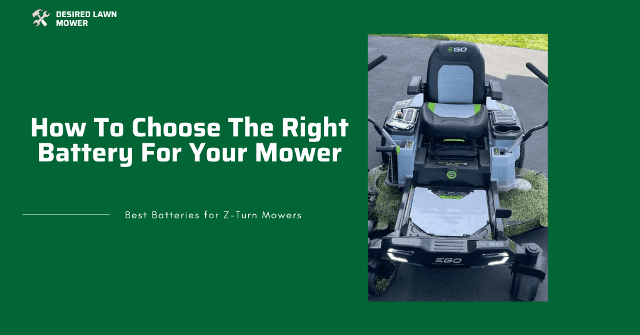
Table of Contents
Things to Consider Before Buying a ZTR Battery
The owner’s manual for your ZTR includes all the information you’ll need to know about replacing the battery. Since there are numerous battery options, though, it’s easy to get misled by the incorrect offer. To help you choose the right battery for your z-turn, here are four important considerations:
What voltage does your zero-turn need
ZTRs typically operate at a voltage of 12V, while it is possible for this number to be off by a few decimal places. Before going out to get a new battery, measure its voltage to make sure you don’t waste your time and money.
If you’re wondering if a small difference in voltage makes a difference, it does—you may hurt yourself in an explosion or severely damage your machine’s engine. If the battery voltage is not marked somewhere, you can look it up in the owner’s manual.
Where You Should Put Your ZTR’s Battery Terminals
When talking about a battery, the terminal position is where the positive and negative cables will be attached. If the battery is in the neutral position, the positive wires will be on the left, and if it is in the positive position, denoted by an R, the cable will be attached to the right. This is very important to think about because faulty connections can create fire in your mower if you accidentally install a battery with unsuitable terminals.
The terminal orientation instructions are included in your vehicle’s manual. The positive cable can be connected to any terminal on various batteries. In order to reduce the possibility of mishaps, the cables should be connected so that no two wires touch each other.
The Battery Size
All zero-turn mowers take batteries of the U1/U1R size. The YTX30Ls are another option, but they are often reserved for heavier machinery. It’s important to note that some ZTR batteries aren’t the normal size. Checking the owner’s handbook or the present battery is the best way to determine what size battery your z-turn needs. Manufacturers will often include this information on the exterior of their products. Since the U1/U1R sizes are the norm for zero-turn mowers, I will focus on those for the sake of the masses.
Power Amplifiers that Start in the Cold (CCA)
At 0 degrees Fahrenheit (-18 degrees Celsius), the cold cranking amp is the highest current a brand-new, fully charged 12-volt battery can supply for 30 seconds without the voltage falling below 7.2V. Most zero-turn mowers only need 145 CCA to start the engine, even in freezing conditions. However, the quality of your mowing experience will improve with a larger number of peak amps. It merely indicates how well your battery can hold up under stress.
The 5 Best Batteries for a Zero-Turn Mower
Best in Class: Max, The Mighty
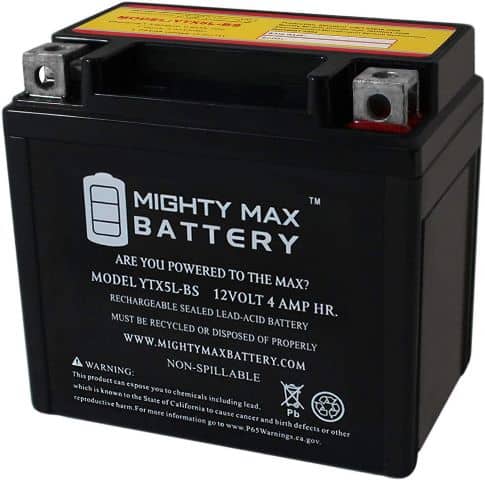
The convenience of being able to use the Mighty Max batteries immediately upon opening the packaging is a key feature of any good battery. This company has earned my highest praise throughout the years for consistently turning out high-quality lead-acid weaponry that is impervious to corrosion and never needs to be replaced. The Mighty Max unit is also 30% simpler to install and operate because it can be placed in any terminal.
Designed for extremely cold climates and equipped with a massive 320 CCA, you’d be on the safest side imaginable, ensuring a great ignition process even in the heat of summer. Even though this model claims to use 99.99 percent pure lead, my experience with lead-acid batteries has shown me that even the best of them have a memory and eventually run out of juice.
The first two years in the air could be a blast, but after that, the batteries start to wear out and the issues only get worse. This is a standard issue with lead-acid batteries and has nothing to do with the manufacturer. Under ideal conditions, the Mighty Max will last for over twice as long as comparable lead-acid batteries (about one year).
I would recommend these for your zero-turn mower because they were obviously built with care and attention to detail.
Nitty-Gritty:
- Weight: 18.71 Ibs
- Type: Lead-Acid
- Terminal Position: Positions that are neutral to both sides can be switched.
| Pros | Cons |
|---|---|
| Enduring strength | Eventually, time and its ability to store information would cause it to run out. |
| Exciting new mower ignition system | |
| Neither leaking nor spilling | |
| Exceptionally Secure |
Best For Cold Regions: Antigravity
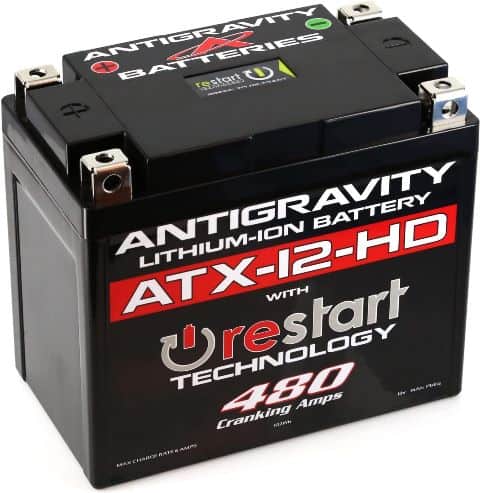
Lithium-Ion cells, unlike the nickel-cadmium batteries often found in riding lawn mowers, are used to power antigravity devices. You would be doing away with the Lead-heaviness, Acid’s spillage, and anything else that comes with it, and going straight for lighter armament that requires less upkeep.
The built-in self-jump-start function is the best feature of this battery. What’s more? Everything about it can be controlled by a separate remote. When the battery goes to sleep, pressing the RESTART button will wake it up with the help of the battery’s built-in technology. However, you probably won’t need to use this feature very often, as the unit is already equipped with 480 CCA.
Battery Management System safeguards Antigravity cells from discharge, overcharge, temperature imbalance, and short circuits, extending the battery’s useful life. Because of the quad terminals installed, the unit may be used in either direction, which is a brilliant design decision on their part that significantly lessens the danger of using the device. I’m pleased to report that a lot of thought and care has gone into the administration of the Antigravity zero-turn battery. This battery is excellent for use in low temperatures.
Nitty-Gritty:
- Weight: 3Ibs
- Type: Lithium-Ion
- Terminal Position: Quad terminal spots leading to a neutral position build-up.
| Pros | Cons |
|---|---|
| Superior invention in technology | It’s not going to work with every zero-turn mower out there. |
| Terrific in chilly climates | Pretty pricey |
| Use | |
| Impressive CCA- 480 |
Best For Residential ZTRs: Interstate Batteries
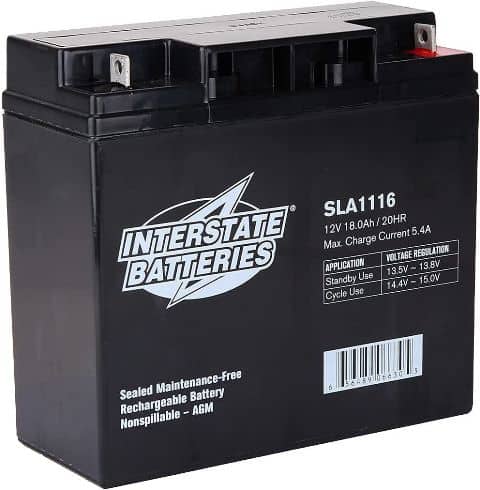
Interstate batteries have been around for quite some time, and throughout that time the company has accumulated a wealth of knowledge that has benefited its clientele. Many changes have been made to the batteries to make it more reliable, effective, and user-friendly. They may not be formidable rivals to the two battery manufacturers we’ve discussed, but they provide everything you need for a worry-free mowing experience.
Significant sealed lead-acid cells produce a CCA of 220, making them ideal for residential zero-turns with top speeds of less than 12 mph. The artillery’s reliability is its strongest suit, and with regular maintenance, it has a lifespan of three to four years. The catch, though, is that they need a lot of upkeep to work properly. Other than that, if you need a simple yet long-lasting battery for your residential zero-turn mower, this is the one to get.
Nitty-Gritty:
- Weight:11.02 Ins
- Type: Sealed Lead Acid
- Terminal position: Positive on the right
| Pros | Cons |
|---|---|
| The ease of use makes it a versatile tool. | Need a bit too much upkeep |
| Superior in terms of durability | Its plastic shell makes it very susceptible to leaks (would need to be treated with ultimate care) |
| Reasonably priced |
Bang For The Buck: Istarpower Lithium Phosphate Batteries
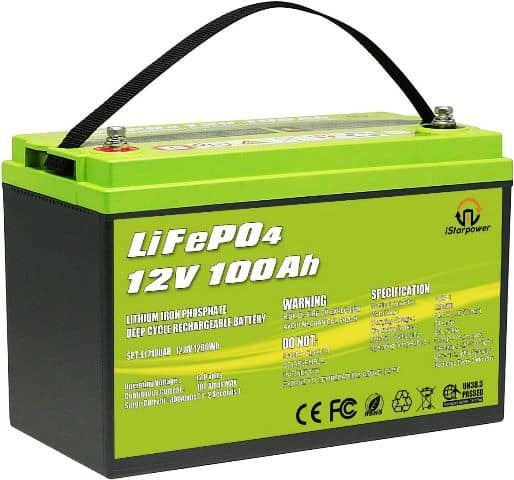
When compared to lithium-ion and especially lead-acid batteries, lithium-phosphate cells come out on top. Since they don’t overheat easily or explode if they do, and can be charged and discharged at a rapid pace, they provide a considerably safer environment in which to interact. As a result, their lifespan is significantly greater than that of comparable batteries.
When you consider that Istarpower units can be stored for up to 350 days before losing efficiency, you’ll be impressed. Their fast discharge and recharge rates make their energy unstable, which can disrupt the ignition process or put extra load on the engine, making them less efficient than lead-acid and lithium-iron batteries. They are a dependable brand that will help you enjoy your lawn for many years with less effort and worry.
Nitty-Gritty:
- Weight: 2.2Lbs
- Type: Lithium-Iron Phosphate
- Terminal Position: Positive on the right
| Pros | Cons |
|---|---|
| 5-year guarantee | It is not compatible with all zero-turn mowers |
| Both lithium-ion and lead-acid batteries are significantly lighter. | Takes a long time to recharge |
| Extremely low-priced |
Easiest To Use: ExpertPower

In the event that your mower battery dies in the middle of a particularly busy mowing week, the ExpertPower battery is an instant solution that may get your zero-turn back on the lawn and cutting again.
The first thing that will satisfy you about these units is that they come fully charged, saving you the time and effort of having to wait for the battery to recharge after shipping. They work well in extremely cold and hot environments, last for three to four years with good care, and require no maintenance, saving you money in the long run on servicing your zero-turn mower.
The ExpertPower battery is an excellent value for the money. The main drawback is that they may not provide as smooth of a cranking experience as some other high-end batteries. Although they may be used on larger machines, their battery life would be depleted much faster than it would be on smaller z-turns, so I recommend only using them with household mowers that go below 12 miles per hour. Although the ExpertPower battery for your ZTR is quite expensive, I cannot stress enough how highly I suggest it due to the high quality it provides for such a low cost.
Nitty-Gritty:
- Weight: 6.04 lbs
- Type: Lead-Acid
- Terminal Position: Positive on right
| Pros | Cons |
|---|---|
| Conveniently pre-charged and ready to go before arrival makes for a quick and simple set-up. | The starting process is rough, and the cranking isn’t much better. |
| Superior in the harshest climates | Is recommended for use only on short zero-degree turns |
| Great for a small budget |
How to Extend the Life of Your Zero-Turn Battery in 3 Easy Steps
With regular charging and maintenance, the battery in your zero-turn mower should last for four to five years. Find out how to maximize the potential of your engine by reading this:
One, maintain a Strict Cleaning Schedule for the Terminals
Corrosion on the battery terminals causes transmission problems and overuse of the artillery, reducing its effectiveness. If corrosion or crystallization has formed on the terminals, use a damp cloth dipped in a solution of baking soda and water to wipe it away. You can also use anti-corrosion spray on the places to guarantee that it doesn’t accumulate any additional debris.
Second, put the battery away for extended periods of inactivity.
Leaving a ZTR battery inside the machine during the winter is the quickest method to kill the battery and render the machine useless when you return. If you remove the battery from the device and store it in a cool, dry place, you can prevent the leakage of current from the cell, as well as the formation of corrosion and crystals.
Third, battery Maintenance and Correct Charging
Batteries can only be charged using a charger of the same voltage as the cell pack. For 12 V batteries, for instance, you would only use a 12 V charger (view on Amazon) Choosing the right charger for your battery is essential. Also, when you are in the process of connecting the charger to the battery, ensure you start with the positive connection first before the negative one. This maintains a steady flow and creates an ideal condition for transmitting the electricity without risk.
In addition, avoid overcharging the battery, as doing so can give the device a memory and drastically reduce the cells’ useful life span. If you follow these important guidelines, you’ll be 90% of the way toward extending the life of your battery.
Getting a new battery for your zero-turn mower requires some careful deliberation. We’ve covered all the bases, so you can make an informed decision about the right battery for your mower. If you know exactly what you need, you can quickly point out which battery is perfect for you like a pro.







